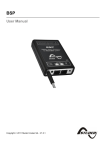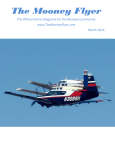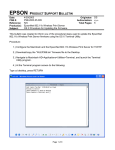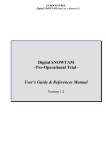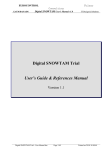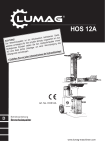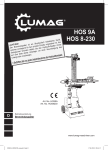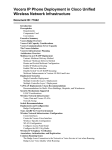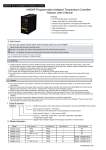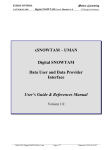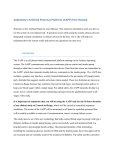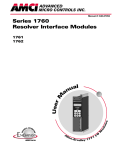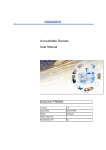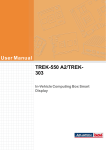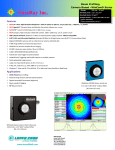Download Digital SNOWTAM - Pre-Operational Trial - User`s
Transcript
EUROCONTROL Digital SNOWTAM Trial User’s Manual v1.4 Digital SNOWTAM - Pre-Operational Trial - User’s Guide & References Manual Version 1.4 EUROCONTROL Digital SNOWTAM Trial User’s Manual v1.4 DOCUMENT CHANGE RECORD Date 06/01/2010 28/02/2010 28/02/2011 12/02/2013 14/11/2013 Description v1.0: first public version V1.1: updated after installation of version 1.0.6 of the application V1.2: updated after upgrade for EAD installation v1.3: updated after upgrade for Google Maps API v3 V1.4: removed all sections about how the application can be used for encoding SNOWTAM, which is not enabled for the EAD installation. Add/modified text related to the new functionality – MyAirports and direct decoding of SNOWTAM on Overview page; changes in the ICAO SNOWTAM format (no longer measured values for friction coefficient) 2 Sections All 3.4, 3.4.1 and 4.4 All All EUROCONTROL Digital SNOWTAM Trial User’s Manual v1.4 CONTENTS 1 DISCLAIMER .................................................................................................................................5 2 ACCESSING THE APPLICATION .............................................................................................6 2.1 2.2 Technical requirements ...............................................................................................................6 Accessing the application ...........................................................................................................6 3 DATA USER INTERFACE ...........................................................................................................7 3.1 Introduction.................................................................................................................................7 3.2 Main screen layout ......................................................................................................................8 3.2.1 Main menu............................................................................................................................8 3.2.2 Main working area ...............................................................................................................8 3.3 Airport Overview ........................................................................................................................8 3.3.1.1 Search criteria ............................................................................................................................ 9 3.3.1.2 Airport contamination status icons .......................................................................................... 11 3.3.1.3 Possible actions on the map: ................................................................................................... 11 3.3.2 Quick Search ......................................................................................................................13 3.4 Find airports ..............................................................................................................................16 3.4.1 Search criteria....................................................................................................................16 3.4.2 Result list ............................................................................................................................17 3.5 Airport Map Page .....................................................................................................................19 3.5.1 Filters .................................................................................................................................21 3.5.2 Airport features ..................................................................................................................21 3.5.2.1 Airport feature ......................................................................................................................... 22 3.5.2.2 Other feature types .................................................................................................................. 23 3.5.3 Airport Map........................................................................................................................24 3.5.4 Visualization Options .........................................................................................................24 3.5.5 Viewing SNOWTAM Text ...................................................................................................26 3.5.5.1 SNOWTAM Draft ................................................................................................................... 27 3.5.5.2 SNOWTAM plain text ............................................................................................................ 27 3.5.5.3 EAD – SNOWTAM ................................................................................................................ 28 3.6 Viewing contaminations ...........................................................................................................29 3.7 Viewing Runway Contaminations ............................................................................................30 3.8 Viewing Taxiway Contaminations ...........................................................................................30 3.9 Viewing Apron Contaminations ...............................................................................................31 3.10 Viewing Aircraft Stand contaminations ................................................................................31 3.11 Local Contaminations............................................................................................................32 4 SYMBOLS AND GRAPHICAL REPRESENTATIONS ..........................................................33 4.1 Features .....................................................................................................................................33 4.1.1 Airport Reference Point .....................................................................................................33 4.1.2 Runways .............................................................................................................................34 4.1.3 Taxiways.............................................................................................................................36 4.1.4 Aprons ................................................................................................................................37 4.1.5 Aircraft Stands ...................................................................................................................37 4.2 Contaminations .........................................................................................................................38 4.2.1 Contamination surface .......................................................................................................39 4.2.2 Contamination icon ............................................................................................................40 4.2.2.1 4.2.2.2 4.2.2.3 Single and multiple layers ....................................................................................................... 40 Type of contaminant................................................................................................................ 40 Friction coefficient .................................................................................................................. 41 3 EUROCONTROL Digital SNOWTAM Trial User’s Manual v1.4 5 WORKING WITH GOOGLE MAPS .........................................................................................42 5.1 5.2 5.3 Moving the map ........................................................................................................................42 Zooming the map ......................................................................................................................43 Choosing a map type ................................................................................................................43 4 EUROCONTROL Digital SNOWTAM Trial User’s Manual v1.4 1 Disclaimer EUROCONTROL does not review, approve or take any obligation and/or responsibility with regard to the adequacy, reliability, accuracy, safety or conformance of the Digital SNOWTAM Trial Data with government standards or any government flight procedures. The User shall inform EUROCONTROL (by contacting the trial helpdesk at the e-mail address [email protected]) of any inaccuracy or error in the Application or Data, which may affect the safety of air navigation. The User shall not: (a) take any operational and/or safety-critical decision based on information displayed by the Application or on Data retrieved from the Trial. All operational decisions shall continue to be based on official SNOWTAM messages received from the official sources to which the User has access; (b) make available the information displayed by the Application to any third party not being part of the User’s organisation; (c) disclose, sell, assign, lease or otherwise provide the Data to any other parties, or (b) commercially exploit or enable the commercial exploitation of the Application and/or the Data. Note: Please take into account that because of the trial nature of the application this contains some features which are unnecessary for pilots but will be used for training purposes of data providers. These features are marked with a hyperlink in the text and will lead you to this note. 5 EUROCONTROL Digital SNOWTAM Trial User’s Manual v1.4 2 Accessing the application The Digital SNOWTAM application is accessible via the Internet as a Web Application. You will therefore need a working Internet connection in order to use it. On the other hand, as far as the technical requirements are fulfilled, no other third party software or components need to be installed on your computer. 2.1 Technical requirements Application was tested with Firefox 23.0 and Internet Explorer 9. Using an earlier version of these browsers might give unexpected results and it is therefore not recommended. All application screens have been developed to accommodate a minimum resolution of 1024x768. Note, however, that the application also supports higher screen resolutions to allow you to take full advantage of the graphical capabilities of the maps. Memory requirements will vary greatly depending on your browser and configuration. 2.2 Accessing the application After login, the following image will be displayed, either in a separate browser window or a separate browser tab page (depending on the browser version). Click on the image to launch the Trial Application. Home page 6 EUROCONTROL Digital SNOWTAM Trial User’s Manual v1.4 3 Data User Interface 3.1 Introduction As Data User, you have access to the Data User Interface, which provides read access to textual and graphical representations of features and contaminations for all airports1, world-wide. The typical usage flow of the Data User Interface is as follows: Login 1. Enter your login name and password Airport Overview 2. 3. An overview of the current SNOWTAM situation (Focus on Europe) Find airports Find Airport Page Quick Search Feature View airport contaminations View the airport, its associated features and contaminations on a map 1 More than 15000 airports are available through EAD export 7 EUROCONTROL Digital SNOWTAM Trial User’s Manual v1.4 3.2 Main screen layout Application screens are divided in multiple sections: 3.2.1 Main menu The Main menu is the heart of the navigation into the application. This is where you can choose the actions you want to perform within the application (Airport overview or Find Airports). Each menu item can be clicked. This will load the requested page into the Main working area. 3.2.2 Main working area The main working area is where the application pages are loaded. 3.3 Airport Overview The ‘Airport Overview’ screen shows a summary of the contamination status of a region It is the page that opens first when entering the application. If a list of preferred airports (MyAirports) is already defined for your account, then only these airports will be shown. Otherwise, all airports having an IATA code in the application database will be shown. This selection criteria (‘has IATA code’ was chosen in order to de-clutter the image, as displaying all airports in the database could make the image very heavy, especially in the Western Europe area. 8 EUROCONTROL Digital SNOWTAM Trial User’s Manual v1.4 It is important to remember that this page does not display by default the situation of all the airports available in the Pilot database! The view is initially centred on Europe. The image will refresh automatically every 5 minutes under the condition that the mouse is not moving in the window. The displayed airports are refreshed every time the map is moved or zoomed. Note: some airports might seem to be missing in the bottom of the map, especially at low zoom levels. This is due to the fact that our geographic queries take the earth curvature into account, but Google Maps doesn’t (coordinates are projected). 3.3.1 Search criteria The ‘Query time UTC’ field (1) allows for historical searches. Click on the ‘Search’ button (2) to do the search. Clicking on the ‘Now’ button (3) will reset the query time by retrieving the current UTC time form server. The button named ‘Show My Airports’ (4) will remain disabled as long as the user’s preference list is empty, as explained in the tooltip (see previous chapter). When the user’s preference list contains at least 1 airport, then the ‘Airport Overview’ screen displays by default only the airports from this preference list and the button (4) is renamed into ‘Show All Airports’. 9 EUROCONTROL Digital SNOWTAM Trial User’s Manual v1.4 Clicking on the ‘Show All Airports’ button will show all airports having an IATA code, as explained in the tooltip. And the button (4) will be renamed into ‘Show My Airports’ to allow coming back to the preference list. 10 EUROCONTROL Digital SNOWTAM Trial User’s Manual v1.4 3.3.13.3.2 Airport contamination status icons A contamination status icon is associated to every airport. The table below illustrates the possible icon colours and their respective meaning: Icon Meaning No contamination information on the airport (no SNOWTAM received and successfully parsed by the application) There exists contamination information but all runway thirds are in good condition, which is defined as: (whatever the contamination information) the friction coefficient is 5 (‘GOOD’) or there is no information for that runway third or the contamination is NIL and the friction coefficient is not specified There is at least one runway third in ‘poor’ condition, which is defined as: (whatever the contaminant) friction coefficient has value 1 The latest SNOWTAM received for this airport could not be parsed because of syntax errors or other problems. The text of the SNOWTAM is available in the AirportOverview. All other situations 3.3.13.3.3 Possible actions on the map: 11 EUROCONTROL Digital SNOWTAM Trial User’s Manual v1.4 Change the map type using the map type selector. Zoom in, zoom out. Drag the map (move it using the mouse to show a different zone). “Hoover” the cursor over a bullet to see the corresponding airport designator. Click on an empty bullet to open the airport page of the corresponding airport/heliport: Click on a coloured bullet to view the details of a SNOWTAM coming from EAD. You can choose the plain text of contamination by clicking on the second tab. 12 EUROCONTROL Digital SNOWTAM Trial User’s Manual v1.4 3.3.23.3.4 Quick Search The Quick Search feature is a convenient way to find airports very easily and quickly, based on ICAO/IATA designators and airport name. The selection of an airport will open the corresponding Airport Map page, which is used to display the contaminations. Type any combination of characters to trigger the search (a minimum of 3 characters is required for the search to take place). The search results will contain all airports whose designators or name match the specified criterion: 13 EUROCONTROL Digital SNOWTAM Trial User’s Manual v1.4 This search field also support the ‘*’ or ‘%’ wildcard characters (replacing any group of letters). Note that the Quick Search feature doesn’t support temporal queries and that the Airport Map Page will always be opened with the current date and time. Once the search results are displayed, you can navigate through the airport list with the keyboard (with up/down arrows) and press the RETURN key to select the airport. You can also use the mouse and click on the desired airport. If the search results contain too many airports, they will be divided in multiples ‘pages’ that can be browsed with the help of the paging toolbar at the bottom of the list: 14 EUROCONTROL Digital SNOWTAM Trial User’s Manual v1.4 Example search results: Criterion LS Results No results (minimum 3 characters needed) LS* All airports where designator ICAO or designator IATA starts with ‘LS’ (no airport name starts with ‘LS’ LSZ All airports where designator ICAO or designator IATA contains ‘LSZ’ (no airport name contains with ‘LSZ’) LSZH LSZH/Zurich (Zurich Airport, Switzerland) BRUSSEL All airports whose name contains ‘BRUSSEL’ (as ICAO and IATA designators have a max length of 4 characters, they will never match any criterion with more than 4 characters so, in that case, only the airport name is taken into account. ‘BRUSSEL’ will match the following airports: CPD4 / BRUSSELS (ARMSTRONG FIELD) EBBR / BRUSSELS/BRUSSELS-NATIONAL EBUB / BRUSSELS/ULB EBUC / BRUSSELS/UCL K4IL7 / BRUSSELS 15 EUROCONTROL Digital SNOWTAM Trial User’s Manual v1.4 3.4 Find airports The ‘Find airports’ screen, always accessible through the ‘Find Airports’ menu item, allows you to find specific airports and show if a SNOWTAM is active for each retrieved airport at ‘query time’. Find airport page for data users 3.4.1 Search criteria Search for airports is allowed by: ICAO designator (1) Airport name (2) IATA designator (3) All those search criteria accept the ‘*’ and ‘%’ wildcard characters (which stand for ‘any group of character’) both at the beginning and/or at the end of the criterion. Both characters have the same meaning and can be used indifferently, depending on your preference. Examples: ‘EB*’ in ICAO field will find all airports whose designator ICAO starts with ‘EB’ (i.e. EBBR, EBOS...) 16 EUROCONTROL Digital SNOWTAM Trial User’s Manual v1.4 ‘*STOCK*’ in Name field will retrieve all airports whose name contains the word ‘STOCK’ (i.e. STOCKHOLM ARLANDA, STOCKTON METROPOLITAN, ...) The ‘Query Time (UTC)’ field (4) allows for historical searches. This field is used by the application to retrieve SNOWTAM information. It will also be used when displaying the Airport Map Page of the selected airport. By default, the field contains the current UTC date/time. Clicking on the ‘Now’ button (5) will reset the query time by retrieving the current UTC time from the server. If ‘My airports’ (6) is selected, the result list will contain only airports from the user’s preference list. Click on the ‘Search’ button (7) or press the ‘RETURN’ key in any field to do the search. 3.4.2 Result list While the server processes the request, the result grid becomes disabled and a loading mask is displayed: When the results are available, the grid becomes enabled again and the first row is selected / highlighted: 17 EUROCONTROL Digital SNOWTAM Trial User’s Manual v1.4 The result table contains the list of airports/heliports matching the search criteria. A row displayed in bold with a bullet in the first column means that the corresponding airport/heliport has a valid/active SNOWTAM at the Query Time. A single-click on the plane icon in the last column or double-click on a row will open the Airport Map Page for the corresponding airport. The result grid also supports keyboard navigation so it is also possible to use the up/down arrow keys to navigate through the results and press the RETURN key to open the Airport Map Page of the highlighted airport/heliport. TIP: if you know the airport designator, type it in the designator field, press the ‘return’ key, wait for the grid to load, press the ‘return’ key again. This will load the Airport Map Page for the corresponding airport, without using the mouse and without complicated handling. I.e.: ‘EBBR’, [Return], [Return]. If the query returns too many results, the list of airports/heliports will be paginated (split in multiple pages). Navigating through multiple result pages is possible with the help of the navigation toolbar at the bottom of the grid: 18 EUROCONTROL Digital SNOWTAM Trial User’s Manual v1.4 3.4.3 Managing “MyAirports” list To add/remove an airport into/from the preference list, first search for it. When found, check/uncheck the corresponding box in the column named ‘My Airports’ and click on the button called ‘Apply changes’. Pay attention that the result list of an airport search is paginated. For example, a search by airport Designator=”LF%” might return hundreds of airports, which will be displayed as a number of Pages, each limited to 15 airports. There is a possibility (using the Select: None, All) to check/uncheck the MyAirport box for all the airports that are displayed on the page (maximum 15!). But you will have to repeat that check/uncheck and the Apply changes for each page! 3.5 Airport Map Page The Airport Map is the second main screen of the application. It offers both textual and graphical view of airport features and contaminations. 19 EUROCONTROL Digital SNOWTAM Trial User’s Manual v1.4 The screen is divided into four areas: Filters Airport features Airport map Visualisation options The left and right columns (the ‘filters/airport features’ and ‘visualization options’ areas can be almost completely hidden to give more space to the map. This may come in handy with smaller screen resolutions. Once collapsed, the panels become only a narrow vertical bar: 20 EUROCONTROL Digital SNOWTAM Trial User’s Manual v1.4 Click on the bar itself to reopen the panels temporarily (the panel will collapse back as soon as the mouse cursor moves over the map) or click on the little arrows on top of the bars to expand the panels normally. Note that each panel can be collapsed and/or expanded individually. 3.5.1 Filters Filters allow you to reload the map with a different query time or a different dataset. The first time the page is loaded, the dataset is selected using the following criterion: ‘Local’ will be selected if the airport has local contaminations (encoded by a local authority) ‘EAD’ will be selected otherwise Users of the application shall always use the ‘EAD’ data set. If you select a different dataset, this dataset will be used once you apply the filter and the page is reloaded. By default the UTC Date/time uses the value selected in the ‘Find airports’ page or the current UTC date/time if you used the Quick Search feature or the Airport Overview page. 3.5.2 Airport features 21 EUROCONTROL Digital SNOWTAM Trial User’s Manual v1.4 The airport features area is a textual list of available features for the selected airport. Features are displayed by their designator / identification and are grouped by feature type: Only the features available through EAD can be displayed here. Feature groups (Airport, Runways, Aprons...) may be expanded or collapsed individually by clicking on the arrows on the right. Click on the arrows on the right-hand side of feature designators to open a contextual menu which will allow you to interact with the corresponding feature (described below). 3.5.2.1 Airport feature Click on the arrows icon on the right-hand side of the airport designator to open its contextual menu: 22 EUROCONTROL Digital SNOWTAM Trial User’s Manual v1.4 From the airport contextual menu you can: Centre the map on the airport reference point Show the current SNOWTAM text (if available) View the currently active baseline details about the airport (this will open in a new popup) 3.5.2.2 Other feature types If the feature has a geometry that can be displayed, clicking on the designator will centre the map on the corresponding feature. Click on the arrows icon on the right-hand side of the feature designator to open its contextual menu. From the airport contextual menu you can: Show the current contamination (if any) View the currently active baseline details about the feature (this will open in a new popup) When contaminations affect a specific feature, the corresponding contamination icon is also visible nearby the feature designator: 23 EUROCONTROL Digital SNOWTAM Trial User’s Manual v1.4 3.5.3 Airport Map The Airport Map is the central piece of the application. It allows graphical visualization of airport features and contaminations (when available). ‘Last updated’ message shows the time of last observation within the selected time frame. For more details about how features and contaminations are displayed on the map, please refer to chapter 4 ‘Symbols and Graphical Representations’. 3.5.4 Visualization Options For some airports with a lot of feature geometries, the map can quickly become overloaded. The ‘Visualisation Options’ panel gives you full control over what is visible on the map. 24 EUROCONTROL Digital SNOWTAM Trial User’s Manual v1.4 By checking/unchecking the boxes, you can show/hide the corresponding feature geometries and/or labels. The box nearby the feature type (Runways....) allows you to completely show/hide specific features in one click. Satellite view of airport map 25 EUROCONTROL Digital SNOWTAM Trial User’s Manual v1.4 Map view of airport map Terrain view of airport map 3.5.5 Viewing SNOWTAM Text When a SNOWTAM message or contaminations are available for the selected airport, the ‘SNOWTAM Text’ button in the bottom-right corner of the map will be enabled. 26 EUROCONTROL Digital SNOWTAM Trial User’s Manual v1.4 Click on this button to open a dialog showing The Original EAD SNOWTAM (as received from EAD) if applicable Contaminations as plain text Contaminations as SNOWTAM draft (as generated by the application) Currently, airport wide contaminations can only be viewed in the “item T)” and “global remarks” fields. This is also the case for information contained in an original SNOWTAM message that couldn’t be attached to a particular feature. This fact is emphasized in the screenshots below. 3.5.5.1 SNOWTAM Draft The SNOWTAM Draft is generated by the application based on the contaminations provided by Data Providers and on the parsing and translation of official ICAO SNOWTAM messages coming from EAD. The SNOWTAM Draft is ICAO compliant. 3.5.5.2 SNOWTAM plain text The “Plain Text SNOWTAM” translates the contamination into a formatted human readable plain text message. 27 EUROCONTROL Digital SNOWTAM Trial User’s Manual v1.4 Note: the fact that the apron was sanded was provided in item T) of the original SNOWTAM: A) ENKB B) 08130721 C) 07 F) 37/37/37 H) 4/4/3 N) A/37 B/37 C/37 R) E/379 W/379 T) F/100/100/100/PCT. SLIPPERY PORTIONS ON TAXIWAYS. APRONS SLIPPERY. APRONS WEST SANDED. TAXIWAYS A B SANDED. The information could therefore not be processed by the application and has been left unchanged and attached to the global remarks. 3.5.5.3 EAD – SNOWTAM The ‘EAD – SNOWTA’ tab contains the original SNOWTAM message as it was received from EAD, without any interpretation or correction, with the SNOWTAM number/year on the first line. If the SNOWTAM was created within the application (so didn’t come from EAD), the tab will only contain the ‘NIL’ value. 28 EUROCONTROL Digital SNOWTAM Trial User’s Manual v1.4 3.6 Viewing contaminations When contaminations are available, they are accessible through the textual feature list on the right, by clicking on the ‘View contamination’ in the corresponding menu: 29 EUROCONTROL Digital SNOWTAM Trial User’s Manual v1.4 This will open a new dialog containing detailed information about the conditions on the selected feature. The contamination information is read-only (it cannot be edited). The dialogs differ depending on the specificities of each feature type and are described in the following chapters. Remember: Currently, global information about the whole airport is only available through the ‘SNOWTAM Text’ feature. This includes the content item T (plain text remark). 3.7 Viewing Runway Contaminations Detailed information about runway contaminations is always accessible through the feature list on the left, by clicking on the ‘View contamination’ in the corresponding menu: Runway contaminations are always displayed by thirds. 3.8 Viewing Taxiway Contaminations Detailed information about taxiway contaminations is always accessible through the feature list on the left, by clicking on the ‘View contamination’ in the corresponding menu: 30 EUROCONTROL Digital SNOWTAM Trial User’s Manual v1.4 3.9 Viewing Apron Contaminations Detailed information about apron contaminations is always accessible through the feature list on the left, by clicking on the ‘View contamination’ in the corresponding menu: 3.10 Viewing Aircraft Stand contaminations Detailed information about aircraft stand contaminations is always accessible through the feature list on the left, by clicking on the ‘View contamination’ in the corresponding menu: 31 EUROCONTROL Digital SNOWTAM Trial User’s Manual v1.4 3.11 Local Contaminations In addition to EAD SNOWTAM messages, the application also supports local contaminations. During the trial, local contaminations can be provided by local airport authorities and/or NOTAM offices. This will allow data providers to encode test data directly within the application, with the help of wizards and graphical editing capabilities. Local contaminations can coexist with EAD contaminations, as they are both considered as completely separate data sets. In other words, local and EAD contaminations won’t impact each other. This will allow, for example, using the application to encode and generate an ICAO SNOWTAM draft and comparing it with the official SNOWTAM issued by the same authority. 32 EUROCONTROL Digital SNOWTAM Trial User’s Manual v1.4 4 Symbols and Graphical Representations Aeronautical experts have investigated the existence of civil, military and other industry conventions and standards that provide requirements or guidelines for the graphical representation of the surface contamination status. 4.1 Features Features for which geometries are available are displayed graphically on a map. Both features represented by a surface and features represented by a point are supported. Airport features represented by a surface are displayed using an outlined blue polygon (the shape is not filled). This is the case for runways, taxiways and aprons. Airport features represented by a point (aircraft stands, thresholds...) are displayed using an icon depending on their type. 4.1.1 Airport Reference Point The airport reference point is displayed using the usual ICAO symbol: The graphical visualization of SNOWTAM messages and contaminations relies heavily on features geometries. If no geometries are available, a warning shall be displayed under the reference point. 33 EUROCONTROL Digital SNOWTAM Trial User’s Manual v1.4 4.1.2 Runways Runways are displayed as outlined blue polygons. In order to be compliant with ICAO Annex 15 – Appendix 2 and OPADD document for the encoding of contaminations and SNOWTAM messages, runways are divided into thirds. The thirds are numbered from the lower runway designator / threshold: 34 EUROCONTROL Digital SNOWTAM Trial User’s Manual v1.4 When no AMDB data is available, runway geometries are computed by using the two threshold point’s coordinates and the published runway width. So, at the very least, runway thresholds should be available in EAD to be able to visualize runways. It may happen that, for some airports, the runway geometry doesn’t match the picture of the runway on the map: This may be due to: An incorrect Google Map image Wrong threshold coordinates or displaced thresholds An incorrect runway width in EAD No runway width (in which case a default value of 45 meters is used) No threshold and no AMDB data available (in which case the application can’t display the runway) Maps of type ‘Terrain’ and ‘Map’ may be less precise than the satellite map (and thus the displayed picture may appear shifted) If needed, the information can be corrected or completed in EAD and sent as an update, which the application will take into account automatically. Here’s a sample representation of a runway, displaying: The runway itself (the blue box) runway thirds runway thresholds runway label and threshold labels 35 EUROCONTROL Digital SNOWTAM Trial User’s Manual v1.4 4.1.3 Taxiways Taxiways are displayed as outlined blue polygons. Here’s a sample view of several taxiways on an airport: 36 EUROCONTROL Digital SNOWTAM Trial User’s Manual v1.4 Taxiway geometries are only available through AMDB data. If such data is available, send the AMDB file for the corresponding airport to EUROCONTROL in order to take advantage of this functionality. 4.1.4 Aprons Aprons are displayed as an outlined blue polygon. Apron geometries are only available through AMDB data. Send an AMDB file for the corresponding airport to EUROCONTROL in order to take advantage of this functionality. 4.1.5 Aircraft Stands Aircraft stands are displayed as blue dot shaped icons. Here’s a sample representation of some aircraft stands. 37 EUROCONTROL Digital SNOWTAM Trial User’s Manual v1.4 In order to avoid overloading the map, aircraft stands labels are not displayed as other feature labels. The labels with the stand designator are displayed when the mouse moves over a stand. Aircraft stands are made available from EAD data. 4.2 Contaminations Feature contaminations are displayed in two ways: 1. The surface of the feature is filled with a colour corresponding to the contaminant of the upper layer 2. A color-coded and triangle shaped icon is placed on the feature, showing the most important information: the friction coefficient and the type of contaminant of the upper layer 38 EUROCONTROL Digital SNOWTAM Trial User’s Manual v1.4 4.2.1 Contamination surface When features are contaminated, their surface is filled using a semi-transparent colour which corresponds to the type of the upper most layer of contaminant: 39 EUROCONTROL Digital SNOWTAM Trial User’s Manual v1.4 While not displayed graphically, the other contaminants are still available in the view/edit dialogs in the application; As an example, consider item F) of the following SNOWTAM message: A)LSZH B)09280852 C)10 F)27/5/9 H)1/3/3 The 1st third of the runway is contaminated by water over ice (value 27); only the water layer is visible for this third. 4.2.2 Contamination icon The contamination icon carries the most important information about the contamination of the corresponding feature: Single or multiple layers Type of contaminant of the top layer Friction coefficient (textual number and colour code) It is meant to be a visual quick summary of the contamination. 4.2.2.1 Single and multiple layers A single triangle is used when there is a single layer of contamination (one single contaminant): Figure 6 Single layer contamination icon When the contamination consists in multiple layers of contaminants, the icon is displayed as a double triangle. Figure 7Multiple layer contamination icon Important notice: the number of triangles does NOT depict the number of layers. 4.2.2.2 Type of contaminant The icon contains the denomination of the upper most contaminant (the top layer). 40 EU UROCON NTROL Digita al SNOWT TAM Triall User’s Maanual v1.4 4.2.2.3 Friction cooefficient The fricttion coefficcient is displlayed using the followiing two con nventions: A number (1-5) A backgground colorr (red, yello ow, green orr gray) The num mber alwayss correspond ds to the esttimated fricction coefficcient. The application usees the same conventionns as the ICA AO SNOWT TAM form (except for the color): Measured Coefficcient Estim mated frictiion 5 GOOD ME 4 EDIUM/GO OOD 3 MEDIUM M ME EDIUM/PO OOR 2 1 POOR Coolor Grreen Yeellow Yeellow Yeellow R Red Grey collor is used when w no coeefficient is aavailable. However, H th his should noot happen. As an exxample, connsider the fo ollowing SN NOWTAM message: m A)EN NAT B)102 290728 C) )11 F)67/ /1/1 G)4/0/0 H)3/55/5 It will bee displayed using the following fo ic ons: 41 EUROCONTROL Digital SNOWTAM Trial User’s Manual v1.4 5 Working with Google Maps Here are a few condensed things to know about Google Map usage. 5.1 Moving the map The map can be moved: By using the map control on the left (as explained in the screenshot) By using drag & drop (click on the map, keep the mouse button down and move the cursor to move the map). By using the arrows, [Page Up], [Page Down], [Home] and [Insert] keys on the keyboard The map can also be centred on a specific place by double-clicking on the corresponding point on the map. Note: In the Airport Map Page, the map can be centered on a feature by clicking on the corresponding feature in the textual feature list (provided that a geometry is available for that feature). 42 EUROCONTROL Digital SNOWTAM Trial User’s Manual v1.4 5.2 Zooming the map The map can be zoomed in and out: By using the map control on the left (as explained in the screenshot) By using the mouse wheel (if your mouse has one) Use the [Insert] key to zoom out A double-click anywhere on the map will centre it on the clicked point. 5.3 Choosing a map type Choosing a map type is as easy as clicking on the select type in the upper-right corner of the map. As map types add a real value to this application, they are further explained in chapter “3.5.4 Visualization Options” on page 24. The application has the capability to retain the selected map type for next time the map is displayed. 43











































